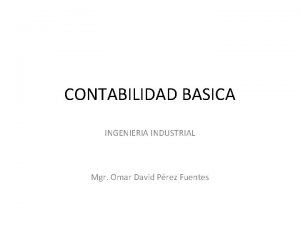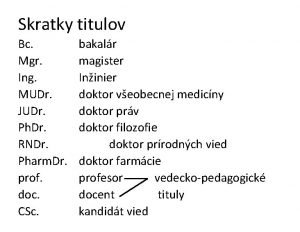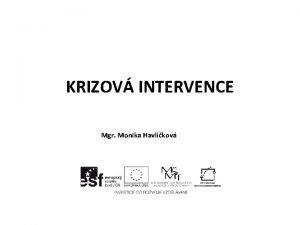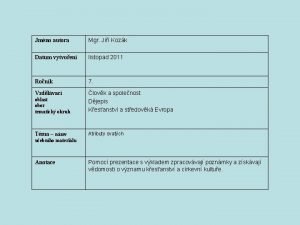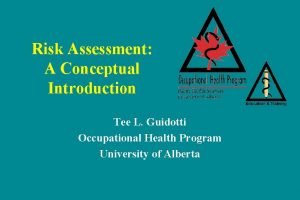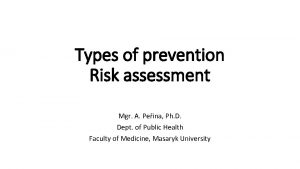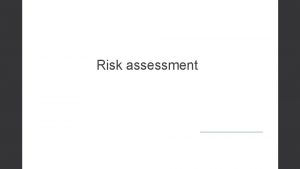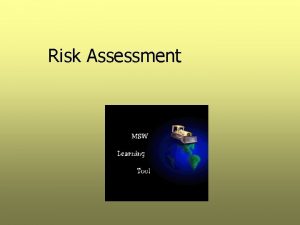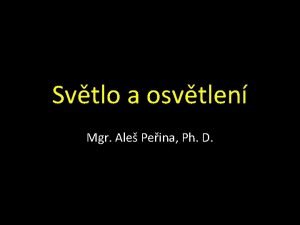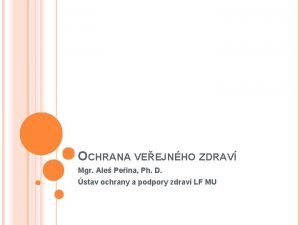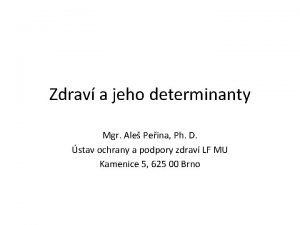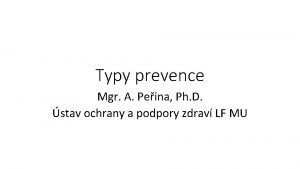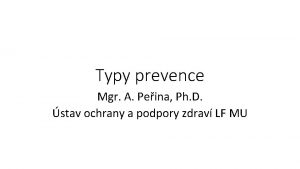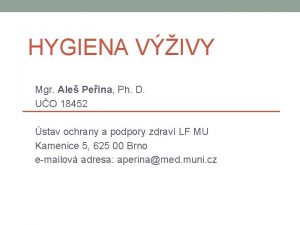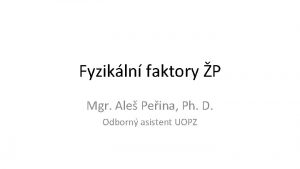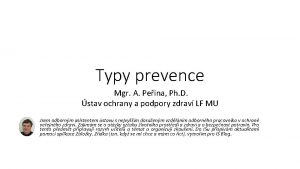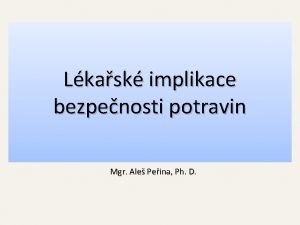Types of prevention Risk assessment Mgr A Peina




































- Slides: 36

Types of prevention Risk assessment Mgr. A. Peřina, Ph. D. Dept. of Public Health Faculty of Medicine, Masaryk University

Health • A state of complete physical, mental and social well-being and not merely the absence of disease or infirmity (WHO, 1948). • Health is neither born nor cultivated in hospitals but it arises and developes wherever people live, play and work, relax and grow old. • Pillars of health care: 1. Health education 2. Disease prevention 3. Health protection + health promotion

Health protection and promotion • Health protection: summary of activities and measures focused on creation and protection healthy living and working conditions aimed at the prevention of infectious and non-infectious diseases • Health promotion: summary of activities helping people to strengthen and improve their health and control their determinants of disease • Sectors involved: health sector, ministries of environment, local development, agriculture, industry, trade, labor and social issues, transport, culture, ministry of defense, ministry of education and sport…

Prevention Type of prevention Tasks Responsibility Primary Influencing disease determinants and reducing health risks Ministries of Health, Environment, Agriculture, Social Affairs, Education etc. Secondary Preventive examinations, screening programs Ministry of Health Tertiary Treatment of diseases and mitigation of their consequences Ministry of Health, M. of Social Affairs Quartery Mitigate the effects of unnecessary or excessive treatment interventions Ministry of Health

Selected campaigns of WHO • Breathe. Life mobilizes cities and individuals to protect people’s and Planet health from the effect of air polution.

Selected campaignes of WHO • Antibiotic resistance: new WHO recommendations are trying to help maintaining the effectiveness of antibiotics used in human medicine by limiting the unnecessary use in animals.

Selected campaigns of WHO Global Hearts" is an initiative to averting the global threat of cardiovascular disease, the world's leading causes of death.

Selected campaigns of WHO • "WHO's Global School Health Initiative", also known as "Health Promotion School": An initiative to promote health and education at local, national, regional and global level. The aim is to improve the health of students, school staff, families and other community members through schools.

Selected campaigns of WHO • Global Action Plan „Healthy enterprise“ addresses all aspects of workers’ health: primary prevention of occupational hazards, protection and promotion of health at work, working conditions and health services for employees of enterprises.

Selected campaigns of WHO • Save. LIVES: road safety package, evidencebased inventory focusing on speed limits, transport infrastructure, vehicle safety, traffic law and regulations and actions increasing the chance of survival after a traffic accident.

The preventive and therapeutic components of medicine are complementary to one another.

Why prevention when we can treat the disease? • Effective prevention reduces the incidence and prevalence of serious diseases. • In most cases, treatment has side effects that can be avoided by effective prevention. • Consistently healthy individual is economically active. • Consistently healthy individual is less sensitive to social, cultural and other differentiation. • Satisfactory environment fulfills well the functions of production, recreation and regeneration. • The zero option means the growing cost of medical technology, the possibilities of which can be (once) exhausted (eg. antibiotics and current resistance, organ transplants and ethical issues etc. ).

Health risks assessment

Hazard vs Risk • Hazard • Characterizes properties of agents • Pathogenicity, toxicity. . . … It may, it could… • Risk • Determines the probability of adverse changes in health status • It is a mathematical function of hazard. • P = 0 … 1 • P = 0 % … 100 %

Probability • Meaning in conversation • Relative frequency of the phenomenon The result can be predicted on the basis of a statistical analysis of a large number of iterations. However: • the life expectancy in the population does not indicate the length of an individual's life. • the likelihood of genetic diseases do not indicate the occurrence of this disease in particular newborns

Pifalls in risk assessment • Risk assessment (among others) = probability of hazard application + emotions • the public knows very little about probability and overestimates its importance • experts (mostly) know very little about emotions; experts must be fully aware of the fact, that • emotions are measurable, as well as the probability is • emotions can be affected as well as the probability • emotions are a legitimate part of the risk

Prioritization of health risks • Why? There a lot of risks that occur in the human environment, but only some of them have a direct impact on human health.

Risk Assessment Attention focuses on human! Hazard identification: can the agent (or active factor) harm health? 1. Dose - effect relationship: what is the numerical relationship between the exposure and the effect on health? 2. Exposure assessment (evaluation): how important is the contact of the individual / population with the agent? 3. Risk characterization: can the assumption of an adverse effect on health be confirmed?

Types of hazard (will be discussed in more detail in specific seminars) • Biological agents • Pathogenic microorganisms (see epidemiological seminars) • Non-pathogenic microorganisms related to health • Toxins as by-products of decomposing and primarily non-pathogenic microflora (fungi and aflatoxins) • Chemicals • Irritating, toxic, mutagenic, teratogenic and carcinogenic effects • Physical factors • Noise, vibration • Nonionizing and ionizing radiation: Special features of therapeutic use: benefit / risk ratio • Microclimate, unilateral strain of muscle groups

Types of dose-effect relationship • Agents with threshold effect • Existence of a safe dose No Observed Adverse Effect Level • Agens with no threshold effect • Non-existence of a safe dose, the probability of an adverse health effect increases • "Slope factor" defined as the size of the inclination angle of no-threshold line (see the figure)

Exposure assessment • Dose offered • It corresponds to the concentration of the agent in the environment (ie in air, water, food, soil), converted to a unit of mass, volume or area of the matrix. • Dose absorbed • It depends on the speed of diffusion and capacity of receptor. • Ingestion, inhalation, contact with skin or mucous membranes • Comment: besides the concentration, the duration of exposure can also determine the size of the effect. • Effective dose • Defined by the concentration of agents in the target organ

Exposure assessment – methods • Indirect methods 1. Environmental monitoring: The amount of agent in the matrix multiplied by the average matrix intake by the exposed person: • • • Average lung volume (22 m 3/person/day) Average water consumption person (1, 9 liter/day) Amount of food consumed person (e. g. Food pyramid) The average length of stay in the swimming pool Inaccuracy! Interindividual differences are significant! 2. Exposure scenario or questionnaire survey: A rough estimation of the exposure can be specified, most often in a well defined population group (typically school pupils, members of the army. . . )

Estimation of individual exposure based on the food pyramid may be difficult.

Exposure assessment – methods II. • Direct methods are preferred but are generally less accessible. • Personal monitoring: • 24 hrs recall, double portion method… • Personal dosimetry - healthcare workers • Biological monitoring • Biomarkers of exposure (genotoxicology of DNA adduct) • Biomarkers of effect (measurable pathophysiological changes in organs) • Biomarkers of sensitivity (measurable susceptibility to health impairment)

Risk characterization 1. Harmful to health has not been confirmed 2. Exposure to harmful factor reduces the level of well-being (health in a broader sense) • Example: The source of environmental noise has forced the use of space (more demanding activities are moved to a quieter part of the building). 3. Exposure to a harmful factor poses a threat to health in the longer term, with the factor being considered at most as one of several disease factors (long-term and multifactorial health effects) 4. Exposure to harmful agents poses an immediate threat to human health or lives • (See the Czech “methanol affair“ in 2012. )

Risk matrix Graphic tool for expressing the risk according to the probability of exposure and the size of the effect.

Uncertainty in health risk assessment • Errors in exposure estimation • Most common • Due to the complexity of the presence of the agent in the matrix (water, soil, air, food, occupational exposure) • The size of individual effective dose in the target organ of the individual • Interspecies extrapolation • In many cases, toxicological data exists only on animal or tissue models • Can be addressed with the development of epidemiological methods of work

Epidemiology • Method of work used to study the distribution of determinants of diseases in the population. • Epi demios (Greek) = Among the people • Descriptive, analytical, experimental and interventional epidemiology use statistical methods; a separate field of biostatistics is being developed. • Focus on the study of infectious and non-infectious diseases.

Epidemiology in health risk assessment Benefits • fundamental role in the scientific concept of protecting public health • no need for interspecies extrapolation • exposure to the harmful agent may be studied in context • no need to extrapolate experimental data to the low dose range

Epidemiology in health risk assessment • Problems: transferability of results • Internal validity of epidemiological studies • Hill's criteria of causality (Sir Austin Bradford Hill, 1897 – 1991) üStrength of association: Even a weak association does not rule out causality if it is weakened by unrecognized confounders üConsistency: Inconsistency with other epidemiological studies does not exclude causality, the effect may only occur under special circumstances üThe causality does not assume the specificity of the effect üThe chronology (time sequence) of exposure and effect is a prerequisite!

Epidemiology in health risk assessment II. Hill's criteria of causality …. continuation üBiological gradient: its absence does not exclude causality, many dependencies can be in the shape of the letter "J" üBiological plausibility: the inability of pathophysiological explanation of the phenomenon may be just the result of the current scientific knowledge üCoherence: Incompatibility with "established" theories does not exclude causality üExperimental evidence: its absence does not exclude causality, as the experiment can also be prevented by ethical reasons üAnalogy: its absence can only be a manifestation of a lack of scientific imagination

Epidemiology in health risk assessment III. • Bias in epidemiological studies üan error in estimating the effect being studied as a result of poor planning or execution of epidemiological studies. It may cause the distortion of the results in terms of both positive or negative. • Basic types of bias in epidemiological studies üSelective bias: e. g. respondents willing to collaborate are not a representative sample of the population üInformation bias is a sign of poor classification in a statistical survey üConfounding bias is a manifestation of the interfering "third" factor of the disease.

Health risk assessment in doctor’s everyday practice Not only in prevention, but also in the diagnosis and treatment of diseases, doctors should ask the following questions (according to the US EPA): üWhat symptoms can be causal in terms of exposure to environmental or occupational hazards? üIs there a safe exposure level for the selected agent? üIs there a possibility that some people will be exposed to significantly different exposure doses? üIs it an exposure of an increasingly vulnerable (susceptible) population group (such as children, pregnant women, sick people, the elderly, people with occupational exposure)?

Public health protection and qualitative research • Qualitative research always just as a complement to epidemiological methods of work • It enables us to understand the social, cultural, economic and behavioral aspects of public health protection • Epidemiological methods: “How many? How much? ” üCalculation of frequency, confidence intervals, the probability of the estimation error (magic “p” value) • Qualitative research: how and why? üFrom the Latin word “Qualis” (= How? What? ) üVerbal analysis of relationships and contexts


Conclusions • Lost health can be restored medically. But: • Creation of health, health protection and health promotion in some ways exceeds the capacity of clinical medicine. • The basis for the protection and promotion of health is a health risk assessment process built on a scientific basis. • Principles of health risk assessment are very useful in clinical practice.
 Primary prevention secondary prevention tertiary prevention
Primary prevention secondary prevention tertiary prevention El mariquita se peina
El mariquita se peina Market risk assessment
Market risk assessment Mgr z kropką czy bez
Mgr z kropką czy bez Mgr luc cyr
Mgr luc cyr Druha punska vojna
Druha punska vojna Mgr. pavol hrvol
Mgr. pavol hrvol Mgr. milan pilát
Mgr. milan pilát Atribuční chyba
Atribuční chyba Contabilidad ingenieria industrial
Contabilidad ingenieria industrial Mgr. veronika fuchsová
Mgr. veronika fuchsová Mgr. petra hovězáková
Mgr. petra hovězáková Iprazak
Iprazak Mgr
Mgr Petr beck
Petr beck Dalibor kott
Dalibor kott Tituly
Tituly Krizová intervence
Krizová intervence Mgr jan kozák
Mgr jan kozák Mgr family tree
Mgr family tree Types of country risk assessment
Types of country risk assessment Risk projection attempts to rate each risk in two ways
Risk projection attempts to rate each risk in two ways Risk reduction vs risk avoidance
Risk reduction vs risk avoidance Relative risk calculation
Relative risk calculation Residual risk and secondary risk pmp
Residual risk and secondary risk pmp Tracing vs vouching
Tracing vs vouching Absolute risk vs relative risk
Absolute risk vs relative risk Activity sheet 2 to risk or not to risk
Activity sheet 2 to risk or not to risk Classification of risk
Classification of risk Pembiayaan risiko (risk financing)
Pembiayaan risiko (risk financing) The biggest risk is not taking any risks
The biggest risk is not taking any risks Key risk indicators financial risk management
Key risk indicators financial risk management Ir x cr x dr
Ir x cr x dr Business vs financial risk
Business vs financial risk Attributable risk
Attributable risk Risk map risk management
Risk map risk management Attributable risk
Attributable risk









